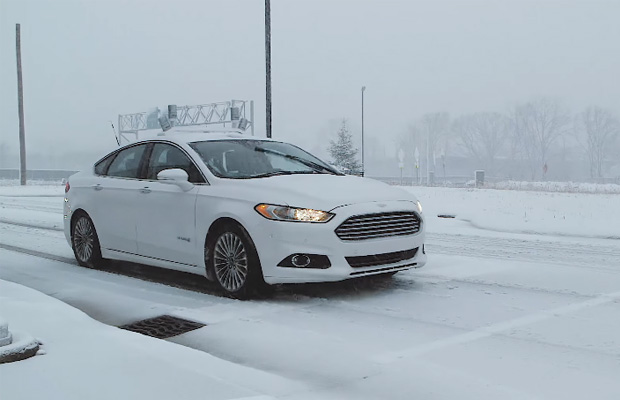Ford’s Future Autonomous Vehicles To Navigate Snowy Roads So You Don’t Have To
Building a self-driving vehicle that can cruise city roadways on sunny days is one thing, but an autonomous vehicle that can handle slippery conditions like snow and ice laden streets? That would be quite the technical feat, though not fiction -- Ford is currently conducting its first autonomous vehicle tests in snow.
There's arguably no better place to do that than Mcity, a 32-acre, full-scale simulated real-world urban environment at the University of Michigan. Mcity provides a realistic driving environment that's isolated from the population at large, including police officers. It's a place that allows for all kinds of real-world driving scenarios, like running red lights or going too fast on a slick road, without the worry of hurting someone or racking up driving infractions.

Ford's fleet of autonomous vehicles have an array of sensors and technologies that provide 360 degrees of coverage. One of those technologies is LiDAR (Light Detection and Ranging), a type of sensor that uses lasers to measure the distance of objects. Where things get tricky is when snow flurries and other adverse weather conditions mess with LiDAR's visibility.
To deal with that, Ford is having its LiDAR sensors look for landmarks that are higher up, like road signs, and combining that information with stored high-resolution 3D maps of the environment that were captured using LiDAR in better weather conditions.
In addition to knowing the landscape, Ford's self-driving cars use a host of algorithms to learn how to drive in adverse conditions. Mcity provides a training ground for Ford's autonomous cars to gain experience on slippery roads and learn how to effectively maneuver them, just as humans do.
Cool (literally) stuff.
There's arguably no better place to do that than Mcity, a 32-acre, full-scale simulated real-world urban environment at the University of Michigan. Mcity provides a realistic driving environment that's isolated from the population at large, including police officers. It's a place that allows for all kinds of real-world driving scenarios, like running red lights or going too fast on a slick road, without the worry of hurting someone or racking up driving infractions.

Ford's fleet of autonomous vehicles have an array of sensors and technologies that provide 360 degrees of coverage. One of those technologies is LiDAR (Light Detection and Ranging), a type of sensor that uses lasers to measure the distance of objects. Where things get tricky is when snow flurries and other adverse weather conditions mess with LiDAR's visibility.
To deal with that, Ford is having its LiDAR sensors look for landmarks that are higher up, like road signs, and combining that information with stored high-resolution 3D maps of the environment that were captured using LiDAR in better weather conditions.
In addition to knowing the landscape, Ford's self-driving cars use a host of algorithms to learn how to drive in adverse conditions. Mcity provides a training ground for Ford's autonomous cars to gain experience on slippery roads and learn how to effectively maneuver them, just as humans do.
Cool (literally) stuff.

